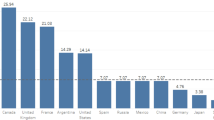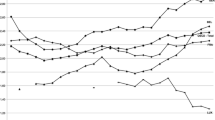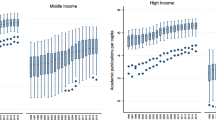Abstract
Scientific research contributes to sustainable economic growth environments. Hence, policy-makers should understand how the different inputs—namely labor and capital—are related to a country’s scientific output. This paper addresses this issue by estimating output elasticities for labor and capital using a panel of 31 countries in nine years. Due to the nature of scientific output, we also use spatial econometric models to take into account the spillover effects from knowledge produced as well as labor and capital. The results show that capital elasticity is closer to the labor elasticity. The results suggest a decreasing return to scale production of scientific output. The spatial model points to negative spillovers from capital expenditure and no spillovers from labor or the scientific output.
Similar content being viewed by others
Notes
Available at: http://data.worldbank.org/indicator.
Available at: http://stats.oecd.org/.
All the results presented in this paper uses linear models. However, Gantman (2012) points that one should consider count-data models when there is the possibility of skewed data, i.e., standard deviations larger than the means. We compared the negative binomial models with the linear models, and used the Akaike Information Criteria to determine that the linear models outperform the count data regression. These results are available upon request.
Another robustness check performed was the analysis for unbalanced panels in all scenarios discussed. The results remain similar in terms of sign and significance of the estimated coefficients. These results are available upon request.
References
Adams, J., Pendlebury, D., & Stembridge, B. (2013). Building bricks: Exploring the global research and innovation impact of Brazil, Russia, India, China and South Korea. New York: Thomson Reuters.
Akhmat, G., Zaman, K., Shukui, T., Javed, Y., & Kahn, M. M. (2014). Relationship between educational indicators and research outcomes in a panel of top twenty nations: Windows of opportunity. Journal of Informetrics, 8(2), 349–361.
Amsden, A. H., & Mourshed, M. (1997). Scientific publications, patents and technological capabilities in late-industrializing countries. Technology Analysis and Strategic Management, 9(3), 343–360.
Bonaccorsi, A., & Daraio, C. (2005). Exploring size and agglomeration effects on public research productivity. Scientometrics, 63(1), 87–120.
Bravo-Ortega, C., & Marín, A. G. (2011). R&D and productivity: A two way avenue? World Development, 39(7), 1090–1107.
Carlino, G., Chatterjee, S., & Hunt, R. (2001). Knowledge spillovers and the new economy of cities, Working Paper No 01–14, Federal Reserve Bank of Philadelphia.
Crespi, G. A., & Geuna, A. (2008). An empirical study of scientific production: A cross country analysis, 1981–2002. Research Policy, 37(4), 565–579.
Doraszelski, U., & Jaumandreu, J. (2013). R&D and productivity: Estimating endogenous productivity. The Review of Economic Studies, 80(4), 1338–1383.
Eid, A. (2012). Higher education R&D and productivity growth: an empirical study on high-income OECD countries. Education Economics, 20(1), 53–68.
Elhorst, J. P. (2014). Spatial econometrics: From cross-sectional data to spatial panels (pp. 20–25). New York: Springer.
Elhorst, J. P., & Zigova, K. (2014). Competition in research activity among economic departments: Evidence by negative spatial autocorrelation. Geographical Analysis, 46(2), 104–125.
Gantman, E. R. (2012). Economic, linguistic, and political factors in the scientific productivity of countries. Scientometrics, 93(3), 967–985.
Getis, A. (2007). Reflections on spatial autocorrelation. Regional Science and Urban Economics, 37(4), 491–496.
Griliches, Z. (1986). Productivity, R&D, and basic research at the firm level in the 1970s. American Economic Review, 76(1), 141–154.
Jaffe, A. B. (1989). Real effects of academic research. American Economic Review, 79(5), 957–970.
Jaffe, A. B., Trajtenberg, M., & Henderson, R. (1993). Geographic localization of knowledge spillovers as evidenced by patent citations. The Quarterly Journal of Economics, 108(3), 577–598.
King, D. A. (2004). The scientific impact of nations. Nature, 430(7), 311–316.
Koljatic, M., & Silva, M. (2001). The international publication productivity of Latin American countries in the economics and business administration fields. Scientometrics, 51(2), 381–394.
LeSage, J., & Pace, K. (2009). Introduction to spatial econometrics. Boca Raton: Taylor & Francis Group LLC.
McAllister, P. R., & Wagner, D. (1981). Relationship between R&D expenditures and publication output for US colleges and universities. Research in Higher Education, 15(1), 3–30.
Meo, S. A., Al Masri, A. A., Usmani, A. M., Memon, A. N., & Zaidi, S. Z. (2013a). Impact of GDP, spending on R&D, number of universities and scientific journals on research publications among Asian countries. PLoS ONE, 8(6), 1–8.
Meo, S. A., & Usmani, A. M. (2014). Impact of R&D expenditures on research publications, patents and high-tech exports among European countries. European Review for Medical and Pharmacological Sciences, 18(2014), 1–9.
Meo, S. A., Usmani, A. M., Vohra, M. S., & Bukhari, I. A. (2013b). Impact of GDP, spending on R&D, number of universities and scientific journals on research publications in pharmacological sciences in Middle East. European Review for Medical and Pharmacological Sciences, 17(20), 2697–2705.
Mueller, C. E. (2016). Accurate forecast of countries’ research output by macro-level indicators. Scientometrics, 109(2), 1307–1328.
Rosenberg, N. (2014). Innovation and economic growth. OECD, Paris. Available at <https://www.oecd.org/cfe/tourism/34267902.pdf>
Rouvinen, P. (2002). R&D-productivity dynamics: Causality, lags, and ‘dry holes’. Journal of Applied Economics, 5(1), 123–156.
Sarwar, R., & Hassan, S. U. (2015). A bibliometric assessment of scientific productivity and international collaboration of the Islamic World in science and technology (S&T) areas. Scientometrics, 105(2), 1059–1077.
Schumpeter, J. A. (1942). Capitalism, socialism and democracy. London: Unwin Paperbacks.
Sharma, S., & Thomas, V. (2008). Inter-country R&D efficiency analysis: An application of data envelopment analysis. Scientometrics, 76(3), 483–501.
Shelton, R. D. (2008). Relations between national research investment and publication output: Application to an American paradox. Scientometrics, 74(2), 191–205.
Solow, R. M. (1957). Technical change and the aggregate production function. The Review of Economics and Statistics, 39(3), 312–320.
van Pottelsberghe de La Potterie, B., & Guellec, D. (2001). R&D and productivity growth: A panel data analysis of 16 OECD countries. ULB—Universite Libre de Bruxelles.
Varga, Atilla. (2000). Local academic knowledge spillovers and the concentration of economic activity. Journal of Regional Science, 40(2), 289–309.
Vinluan, L. R. (2011). Research productivity in education and psychology in the Philippines and comparison with ASEAN countries. Scientometrics, 91(1), 277–294.
Acknowledgements
This paper was the co-recipient of the Best Paper by Graduate Student in Economics Award at the 54th Annual Conference of the Academy of Economics and Finance - Charleston SC, 2017.
Author information
Authors and Affiliations
Corresponding author
Appendices
Appendix 1
See Table 10.
Appendix 2: Results using lag variables
In this appendix, we address an important discussion in the production of scientific outcome, namely the delayed effect of investment in capital and labor on scientific output. As part of the production of scientific output, we know that to produce and publish articles time is important, as it can take several months, or years, to run an experiment, write the report and have it published. Therefore, we can expect a lag effect of capital and research investment on the output of scientific production.
Below we reproduce Tables 2, 3, 4, 5, 6, 7, 8 and 9 using a one year lag in our explanatory variables. Again, we will focus the analysis in model (4) with country and year fixed effects and the Spatial Durbin Model, both of which are our preferred models. Tables 11, 12, 13 and 14 present the non-spatial models and Tables 15, 16, 17 and 18 present the spatial models. Different then the results in the main text, now capital investment is positive across all models specifications but labor is not statistically significant, and when it is, it can be negative (Table 14—BE researchers). This is not a totally unexpected result, but in our opinion tells only part of the story as current researchers should be important in explaining current scientific productions.
Therefore, combining both results should provide a better overall picture. In term of spatial spillovers we have mixed evidences: (1) for WB Sample positive spillover of researcher and negative spillover of capital; (2) OECD Sample: positive spillover of capital and negative spillover of labor cost but no statistical significance for either capital or labor when we use the number of researcher measures. Therefore, we cannot conclude if lagged researchers and capital influenced in neighboring countries. Nevertheless, the results seems consistent with the ones presented in the main text and help to tell a better story.
Rights and permissions
About this article
Cite this article
Erfanian, E., B. Ferreira Neto, A. Scientific output: labor or capital intensive? An analysis for selected countries. Scientometrics 112, 461–482 (2017). https://doi.org/10.1007/s11192-017-2369-z
Received:
Published:
Issue Date:
DOI: https://doi.org/10.1007/s11192-017-2369-z




